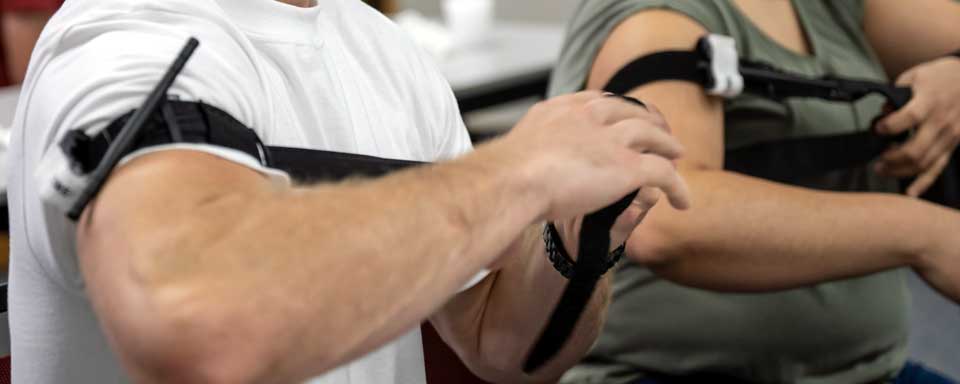
free shipping on orders over $49
We're having a 15% off sale on all our products. Enter your email below to be notified about future sales.




“Stop the Bleed” is an essential and impactful national awareness campaign that seeks to educate the public on how to control bleeding during emergencies. Notably, during emergencies, the first few minutes are critical to saving someone’s life, and knowing how to stop blood loss can spell the difference between life and death. We cannot overemphasize the importance of being informed, as accidents can happen anywhere, and having these crucial skills could save someone’s life. Much like needing to defend yourself, as police are always minutes away, basic first aid is necessary as EMTs are also minutes away.
This unique campaign encourages the learning of basic, simple steps that could help individuals effectively manage blood loss and turn them into first responders who can verbally communicate with medical professionals. Additionally, Stop the Bleed aims to standardize training and materials to help more and more citizens to embrace the life-saving skills taught in the program.
Indeed, the campaign is highly effective in emergencies where no medical professionals might be at hand, such as in cases of mass shootings or natural disasters. By undergoing the training, individuals learn how to use compression techniques, dress and pack wounds, and properly apply tourniquets. These simple skills have proven to dramatically increase the chance of survival, if not save, a victim’s life.
Therefore, it’s prudent to encourage a higher number of individuals to engage in Stop the Bleed training. This way, we could be confident that more people are equipped with the skills needed to intervene in emergencies, saving lives and restoring hope to the affected persons and their loved ones.
The Stop the Bleed campaign teaches people how to use simple tools, such as tourniquets and pressure bandages, to stop bleeding until medical help arrives. The campaign also teaches people how to identify bleeding, how to assess the severity of bleeding, and how to call 911.
The Stop the Bleed campaign has been successful in raising awareness about the importance of bleeding control. Since its inception, the campaign has trained over 1 million people in bleeding control. The campaign has also helped to increase the availability of bleeding control supplies in public places, such as schools, workplaces, and sporting events.
If you are interested in learning more about the Stop the Bleed campaign, you can visit the ACS website at www.stopthebleed.org. You can also find Stop the Bleed training courses in your community by visiting the National Bleeding Control Association website at www.nbca.org.
Here are some of the steps you can take to stop bleeding:
By following these steps, you can help to save a life.
There are a few ways to find Stop the Bleed classes locally.
Once you have found a few classes, you can compare them to find the one that best meets your needs. Some factors to consider include the cost of the class, the length of the class, and the location of the class.
It is important to note that not all Stop the Bleed classes are created equal. Some classes are more comprehensive than others. When choosing a class, it is important to make sure that the class will teach you the skills you need to stop bleeding in an emergency.
Here are some of the things you should look for in a Stop the Bleed class:
If you are interested in taking a Stop the Bleed class, I encourage you to do your research and find a class that meets your needs. By taking a Stop the Bleed class, you can learn the skills you need to save a life.
An IFAK, or Individual First Aid Kit, is a small, portable kit that contains essential first aid supplies. It is designed to be carried by individuals who may need to provide first aid in an emergency situation.
Everyone should have an IFAK. An IFAK can be a lifesaver in the event of an emergency. Even if you are not trained in first aid, having an IFAK can help you to provide basic care to someone who is injured.
Here are some reasons why everyone should have an IFAK:
The contents of an IFAK will vary depending on the individual’s needs and the environment in which they will be used. However, there are some basic items that should be included in all IFAKs. These include:
It is also important to include instructions on how to use the supplies in the IFAK. This can be done by including a first aid manual or by writing out the instructions on a piece of paper and placing it in the kit.
IFAKs should be stored in a cool, dry place and should be checked regularly to make sure that the supplies are still in good condition. They should also be replaced when the supplies are used or when they expire.
Here are some additional tips for choosing and using an IFAK:
By following these tips, you can ensure that you have the supplies you need to provide first aid in an emergency situation. Pepper spray and an IFAK won’t solve every emergency, but they will certainly help out.
As always, be safe and be prepared.
Black Belt Defender
1867 Caravan Trail #105
Jacksonville, FL 32216-2006
Call us toll-free: (800) 859-5566
Mon-Fri: 9:00 am – 5:00 pm EST
NH based, FL Warehouse
Online Orders: 24/7/365

